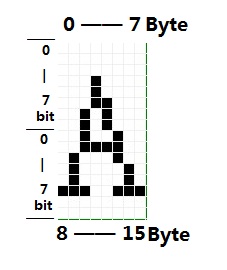转自:http://blog.csdn.net/exbob/article/details/6532772
开发环境:
Win7,Eclipse,MinGW
1、生成ASCII字符文件
ASCII编码的可打印字符是0x20~0x7E,先用运行下面这段代码,生成一个包含全部可打印字符的txt文件:
-
#include <stdio.h>
-
#include <stdlib.h>
-
-
int main(int argc,char *argv[])
-
{
-
FILE * fp;
-
unsigned char i = 0;
-
-
fp = fopen("ascii.txt","w");
-
if(fp == 0)
-
{
-
perror("open");
-
return -1;
-
}
-
for(i=0x20;i<0x7F;i++)
-
{
-
fputc(i,fp);
-
}
-
-
return 0;
-
}
运行后,用记事本打开ascii.txt文件,会看到如下文本:

2、生成字模数据
使用字模提取V2.1软件,设置字体为宋体、12,纵向取模,字节倒序(即高位在下)。这些设置可以根据实际情况设置。用C51格式生成字模,大小是8*16,每个字符用16个字节表示。如字符A的显示如下:

取模数据为:
0x00,0x00,0xC0,0x38,0xE0,0x00,0x00,0x00,0x20,0x3C,0x23,0x02,0x02,0x27,0x38,0x20,
然后将所有的字模数据复制到一个文本文件,删除其中的空行,换行,注释等与字模数据无关的内容,并将文件最后的一个逗号改为ASCII字符的句号,得到一个纯字模数据文件ascii_zk.txt
3、将字模数据文件转换为二进制文件
将ascii_zk.txt文件中的每个字模数据转换为占一个字节的数,将所有的数据填充为一个二进制文件ascii_zk.bin。这样,按照ASCII码的顺序,ascii_zk.bin中每16个字节就可以绘制一个字符。文件转换的程序如下:
-
#include <stdio.h>
-
#include <stdlib.h>
-
-
-
-
unsigned char c2x(char ch)
-
{
-
unsigned char temp=0;
-
if(ch>=0x30 && ch<=0x39)
-
temp = ch-0x30;
-
else if(ch>=0x41 && ch<=0x46)
-
temp = 0x0a+(ch-0x41);
-
else if(ch>=0x61 && ch<=0x66)
-
temp = 0x0a+(ch-0x61);
-
else
-
temp =0xff;
-
return temp;
-
}
-
-
int main(void)
-
{
-
char buffer[5];
-
unsigned char ch=0;
-
-
int i=0;
-
-
FILE *frp=0;
-
FILE *fwp=0;
-
-
for(i=0; i<5; i++)
-
buffer[i] = 0;
-
-
frp=fopen("ascii_zk.txt","r");
-
fwp=fopen("ascii_zk.bin","w");
-
-
while(buffer[4] != 0x2e)
-
{
-
for(i=0; i<5; i++)
-
buffer[i]=fgetc(frp);
-
ch = c2x(buffer[2]);
-
ch = ch*16;
-
ch = ch+c2x(buffer[3]);
-
-
fputc(ch,fwp);
-
-
}
-
-
fclose(frp);
-
fclose(fwp);
-
-
return 0;
-
}
字库文件制作完毕。
4、字库文件ascii_zk.bin的使用
ascii_zk.bin文件从ASCII码的空格(0x20)开始,每16个字节表示一个字符的点阵字模。以字母A为例,它的ASCII码是0x41,那么,它的字模数据的开始位置就是:
(0x41-0x20)*16
从这个位置开始依次读取16个字节,就是字母A的字模数据,将其显示即可。
例:用Linux的终端模拟显示点阵字符,终端屏幕中的每个字符位置就是一个点,程序如下。
-
#include <stdio.h>
-
#include <unistd.h>
-
#include <curses.h>
-
-
#define START 0x20
-
#define DATANUM 0x10
-
-
int displaychar(FILE *fp,char dispch,char fillch,char start_x,char start_y);
-
-
int main(void)
-
{
-
FILE* fp=0;
-
-
int i = 0;
-
const char * teststring="I love Julia";
-
-
fp=fopen("ascii_zk.bin","r");
-
-
-
initscr();
-
-
for(i=0;(teststring[i]!=0);i++)
-
{
-
displaychar(fp,teststring[i],'*',0+(i*8),0);
-
}
-
-
refresh();
-
-
while(1);
-
-
endwin();
-
fclose(fp);
-
return 0;
-
}
-
-
-
-
-
-
-
-
int displaychar(FILE *fp,char dispch,char fillch,char start_x,char start_y)
-
{
-
int location = ((dispch-START) * DATANUM);
-
char x=start_x;
-
char y=start_y;
-
-
int i=0;
-
int j=0;
-
char buf=0;
-
-
-
fseek(fp,location,SEEK_SET);
-
-
for(i=0;i<DATANUM;i++)
-
{
-
buf = fgetc(fp);
-
-
-
for(j=0;j<8;j++)
-
{
-
move(y+j,x);
-
if(buf & (0x01<<j))
-
addch(fillch);
-
}
-
-
if(x == (start_x+7))
-
{
-
x = start_x;
-
y = (start_y+8);
-
}
-
else
-
{
-
x++;
-
}
-
}
-
-
return 0;
-
}
该程序在Fedora12的终端中运行,效果如下:

下载:
ASCII点阵字库文件


